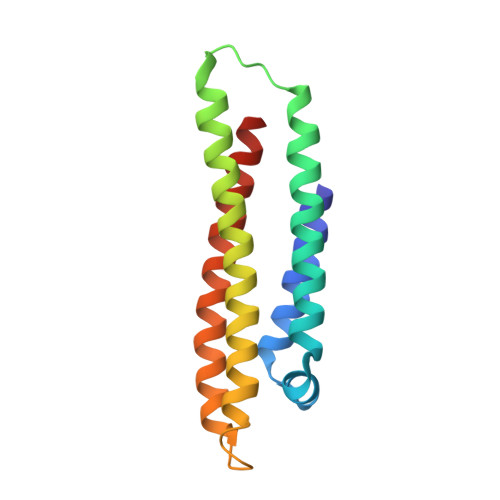Human apolipoprotein E. Role of arginine 61 in mediating the lipoprotein preferences of the E3 and E4 isoforms.
Dong, L.M., Wilson, C., Wardell, M.R., Simmons, T., Mahley, R.W., Weisgraber, K.H., Agard, D.A.(1994) J Biological Chem 269: 22358-22365
- PubMed: 8071364
- Primary Citation of Related Structures:
1LE4 - PubMed Abstract:
Human apolipoprotein (apo) E4 (arginine at residue 112) preferentially associates with very low density lipoproteins (VLDL), and apoE3 (cysteine at 112) associates with high density lipoproteins. It has been postulated that the amino-terminal domain, which contains residue 112, influences the lipoprotein preference by interacting with the carboxyl-terminal domain, which contains the lipid-binding region. To delineate the region in the carboxyl-terminal domain mediating lipoprotein binding and involved in isoform preference, we produced truncated apoE3 and apoE4 variants (terminating at residues 251, 260, 266, or 272) in Escherichia coli and assessed them for lipoprotein association. This analysis suggested that residues 260-272 contain important determinants for complete lipoprotein association and isoform preferences. To determine whether positive charge at residue 112 was an absolute requirement for the apoE4 VLDL preference, we compared the distributions of rabbit apoE (equivalent to apoE3, with cysteine at a position corresponding to 112), canine apoE (arginine at the corresponding site), and cysteamine-treated rabbit apoE (cysteine converted to a positively charged residue). Surprisingly, all distributed like human apoE3, suggesting that positive charge at a position corresponding to 112 was not directly responsible for the isoform preference and that other residues in the amino-terminal domain were involved. To determine which residues were involved, the structure of the apoE4 22-kDa fragment (the amino-terminal two-thirds of the molecule) was determined to 2.5 A by x-ray crystallography. Compared with the known four-helix bundle structure of apoE3, the only significant differences in the apoE4 structure were that glutamic acid 109 formed a salt bridge with arginine 112 and that the arginine 61 side chain was displaced to a new position. Site-directed mutagenesis of glutamic acid 109 in apoE3 and arginine 61 in apoE4 demonstrated that the position of the arginine 61 side chain in apoE4 was critical in determining apoE4 lipoprotein distribution, suggesting that arginine 61 interacted with the carboxyl-terminal domain to direct binding to VLDL.
- Gladstone Institute of Cardiovascular Disease, University of California, San Francisco 94141-9100.
Organizational Affiliation:
















